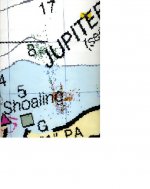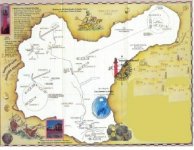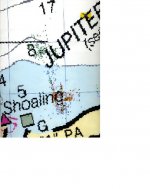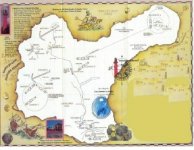itmaiden
Hero Member
- Sep 28, 2005
- 575
- 7
Hey Everyone,
We've been discussing the 1715 Hurricane in one of the posts below. The diameter, speed, and direction of the Hurricane can only be speculated since we have no accurate scientific records for that time period. According to the accounts given, the Hurricane was pretty bad.
The Flagship sank supposedly after being blown against a reef and being split in two with the upper deck splitting from the lower deck. Another ship which apparently observed the sinking of the Flagship said the Flagship sank "4 hours earlier", referencing that their ship was still afloat and maintained floatation for some time though pushed toward the shore. The Hurricane could have been a Category 3 or higher.
As the force of the Hurricane increased the ships were pushed closer to shore. Some were anchoring in 30-40 feet of water as a last ditch effort to save themselves and their ships.
The manifests were different for each ship as well as the number of crew, and whether they carried other passengers. The size and volume of each ship differed.
*Chests of gold are generally going to be heavier than chests of silver
*Iron chests are heavier than wood chests
*Porcelain is lighter and we know from a couple of accounts was stored in wooden chests
*Free objects of utilitarian or ornamental use were usually small and lighter
*Iron cannons are heavy
*The wood from ships would be quite buoyant
We know from written records that the ships were heavily loaded which meant less air space within the ships themselves making them more susceptible to sinking. History tells us it is a common practice to throw heavy objects overboard to save a ship. There does not appear to have been any time or thought to doing that with the 1715 fleet, so we assume the treasure all went down with the ships.
Now comes the problem of determining the buoyancy of any part of the ship and it's objects considering the speed, depth, volume of water available at the time the ships sank along with direction.
Dell Winders wrote in a posting below:
>This is a great intellectual discussion for Historians and Archaeologist. I enjoy it, but do you have any information for Treasure Hunters? Which direction did the tons of Gold end up at? <
I jokingly replied "down". However, I was only halfway joking.
Gold is heavier than any other object on board any of these ships. It was being shipped in different forms; coinage, bars, chains, etc. The same with the silver.
The closer the ship made it to shore before breaking up, the closer the treasure made it in all forms. We know treasure was stored in different parts of the ships depending on what it was, and who it belonged to. Treasure can be stored in the forecastle, a stern castle or even placed on lower decks above the ballast and in some historical ships "as ballast". This is aside and apart from personal items of value carried or worn by passengers and crew.
The work involves determining the position/location of each ship before it sank or broke up, how it broke up, and what water forces it was contending with at the moment.
Different ships broke up at different depths though we know most if not all made it fairly close in to shore if not right on shore.
The ships can be easily anywhere from shore to 3/4 mile out.
Some ballast piles are known and those are the best to work with at the present time.
While a Stern Castle would have a good amount of "air space" to contribute to buoyancy, if it broke apart and water got in, it would have sank shortly after separation from the ship if it was overpacked or packed with heavy and dense objects made of lead, iron, gold, and even gems. If the individual chests broke out of the stern castle or other areas of ship storage, and they were heavy, we must consider the weight/density, the type of chest and calculate possible water displacement to determine how buoyant the object would be to estimate the distance it could have travelled from the associated sections of the ship.
This obviously does not apply well to ships that made it extremely close to shore before breaking up as the treasure would have been contained better, and would have been in shallower water, thus would not have travelled as far from the ship as lighter debris.
Once a chest of gold hits ocean bottom, how far could water forces push it along the bottom ?
So given there has been collaboration between archaeology and treasure hunters, and some treasure has been mapped and salvaged, has anyone given any consideration to the weight/density and mass of the items salvaged and where they were mapped in location to the ballast piles or ship hulls etc, for the purpose of calculating how far from those areas any other chest or heavy object could have travelled? We must consider cannon shape gives way to a more even water displacement than a chest of gold so cannon could float or travel for longer distances as well as the ship framework.
itmaiden
We've been discussing the 1715 Hurricane in one of the posts below. The diameter, speed, and direction of the Hurricane can only be speculated since we have no accurate scientific records for that time period. According to the accounts given, the Hurricane was pretty bad.
The Flagship sank supposedly after being blown against a reef and being split in two with the upper deck splitting from the lower deck. Another ship which apparently observed the sinking of the Flagship said the Flagship sank "4 hours earlier", referencing that their ship was still afloat and maintained floatation for some time though pushed toward the shore. The Hurricane could have been a Category 3 or higher.
As the force of the Hurricane increased the ships were pushed closer to shore. Some were anchoring in 30-40 feet of water as a last ditch effort to save themselves and their ships.
The manifests were different for each ship as well as the number of crew, and whether they carried other passengers. The size and volume of each ship differed.
*Chests of gold are generally going to be heavier than chests of silver
*Iron chests are heavier than wood chests
*Porcelain is lighter and we know from a couple of accounts was stored in wooden chests
*Free objects of utilitarian or ornamental use were usually small and lighter
*Iron cannons are heavy
*The wood from ships would be quite buoyant
We know from written records that the ships were heavily loaded which meant less air space within the ships themselves making them more susceptible to sinking. History tells us it is a common practice to throw heavy objects overboard to save a ship. There does not appear to have been any time or thought to doing that with the 1715 fleet, so we assume the treasure all went down with the ships.
Now comes the problem of determining the buoyancy of any part of the ship and it's objects considering the speed, depth, volume of water available at the time the ships sank along with direction.
Dell Winders wrote in a posting below:
>This is a great intellectual discussion for Historians and Archaeologist. I enjoy it, but do you have any information for Treasure Hunters? Which direction did the tons of Gold end up at? <
I jokingly replied "down". However, I was only halfway joking.
Gold is heavier than any other object on board any of these ships. It was being shipped in different forms; coinage, bars, chains, etc. The same with the silver.
The closer the ship made it to shore before breaking up, the closer the treasure made it in all forms. We know treasure was stored in different parts of the ships depending on what it was, and who it belonged to. Treasure can be stored in the forecastle, a stern castle or even placed on lower decks above the ballast and in some historical ships "as ballast". This is aside and apart from personal items of value carried or worn by passengers and crew.
The work involves determining the position/location of each ship before it sank or broke up, how it broke up, and what water forces it was contending with at the moment.
Different ships broke up at different depths though we know most if not all made it fairly close in to shore if not right on shore.
The ships can be easily anywhere from shore to 3/4 mile out.
Some ballast piles are known and those are the best to work with at the present time.
While a Stern Castle would have a good amount of "air space" to contribute to buoyancy, if it broke apart and water got in, it would have sank shortly after separation from the ship if it was overpacked or packed with heavy and dense objects made of lead, iron, gold, and even gems. If the individual chests broke out of the stern castle or other areas of ship storage, and they were heavy, we must consider the weight/density, the type of chest and calculate possible water displacement to determine how buoyant the object would be to estimate the distance it could have travelled from the associated sections of the ship.
This obviously does not apply well to ships that made it extremely close to shore before breaking up as the treasure would have been contained better, and would have been in shallower water, thus would not have travelled as far from the ship as lighter debris.
Once a chest of gold hits ocean bottom, how far could water forces push it along the bottom ?
So given there has been collaboration between archaeology and treasure hunters, and some treasure has been mapped and salvaged, has anyone given any consideration to the weight/density and mass of the items salvaged and where they were mapped in location to the ballast piles or ship hulls etc, for the purpose of calculating how far from those areas any other chest or heavy object could have travelled? We must consider cannon shape gives way to a more even water displacement than a chest of gold so cannon could float or travel for longer distances as well as the ship framework.
itmaiden









